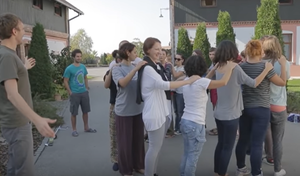DIFFERENTIATION
In this lesson on global warming (the subject can be structured according to the course content), the basic content to be gained by the learners will be given through graded worksheets. Worksheets (WS)-1 and 2 contain texts that provide background information about global warming. While WY-1 explains global warming in a more detailed and academic way, WY-2 deals with the topic in a more popular and simple way. The facilitator cuts out the sentences from both texts beforehand and organizes them into a set of flashcards. The task of the groups is to find a set of flashcards
is to put these sentences in order in a meaningful way. Before doing this activity, the facilitator divides the learners into groups in terms of prior knowledge/skills, with the lower and higher level learners in separate groups (let's consider the presence of inclusion learners, Syrian nationality learners and disadvantaged learners in our classrooms without ignoring them and try to look holistically to include all learners). The group of lower level learners is given the flashcards in CY-2 and the higher level group is given the flashcards in CY-1. The learners are asked to work in groups to create a coherent text based on the sentences. At the end of the study, the correct text is distributed to the groups and they are asked to compare it with the text they created and correct their mistakes. The whole text is asked to be reread by the group and then a class discussion is held to discuss what global warming is. In the second part of the lesson, teaching is differentiated in terms of grouping, output and facilitator support. Learners are divided into homogeneous groups and told that they are people who have started out as global warming experts. Each group is assigned a specific task area. The groups will first make a list of global warming malpractices related to their task area based on the media and their previous experiences (Alternatively, if possible, the groups can make real-life observations of their task area). After creating the list, the groups are asked to describe the situations they face, how they feel about them and their experiences with these situations. They are then asked to develop solutions to these problems. While the lower group of learners are given places where they can more easily identify our practices that lead to global warming, the groups of higher level learners are given more difficult places.
Accordingly, an assignment can be made as follows:
Group 1: A factory (lower level);
Group 2: A highway (lower level);
Group 3: A school (middle level);
Group 4: A city survey (upper level);
Group 5: A house (upper level).
When working in groups, especially in groups with sub-groups of learners, the facilitator provides support in a gradual way, adopting a support strategy as described above. In addition to this, differentiation can be provided in terms of the support to be given to the learners by giving Information Sheet 1 to the groups that are blocked about what kind of problems and what kind of possible solutions there may be. The groups first write their findings on a sheet of paper. Then they transfer this list to a large cardboard as described below. In this way, differentiation is made in terms of the desired output from the learners.
Factory group: They show the problems they see here by drawing a picture. Alternatively, they can write a poem or compose a song (the choice should be left to the group).
Highway group: They prepare a Venn diagram for environmentally sensitive and insensitive transportation.
School group: Design a poster about what other students can do.
City group: They prepare a concept map showing the development of urbanization over time and its impact on nature.
Home group: Design a brochure on precautions that can be taken at home. (The brochure should include a glossary, definitions and precautions)
Groups present their products to the whole class and receive feedback.
Method Details
This method addresses
Added by
Contact with the Author
DIFFERENTIATION 0 reviews
Login to Write Your ReviewThere are no reviews yet.















